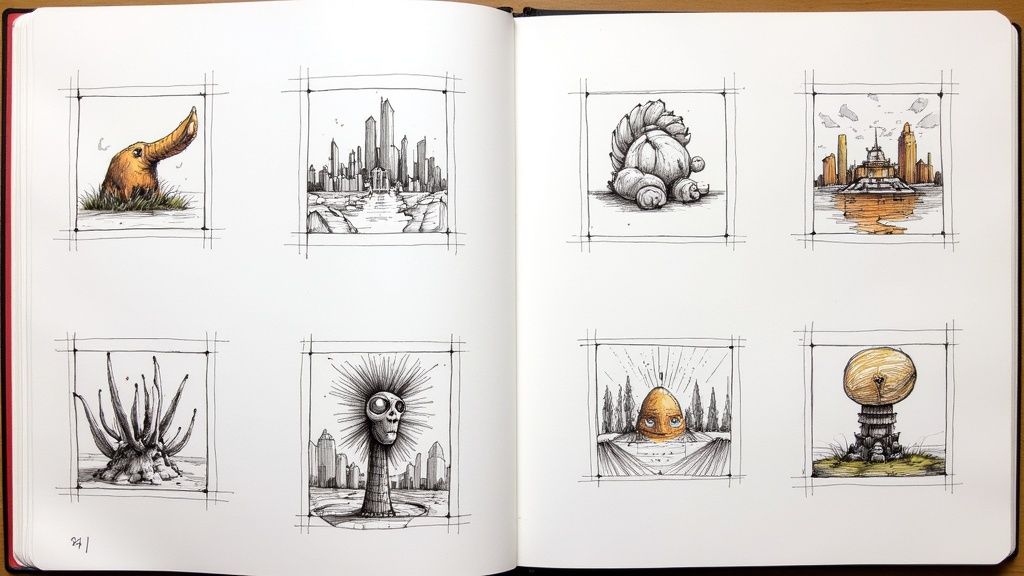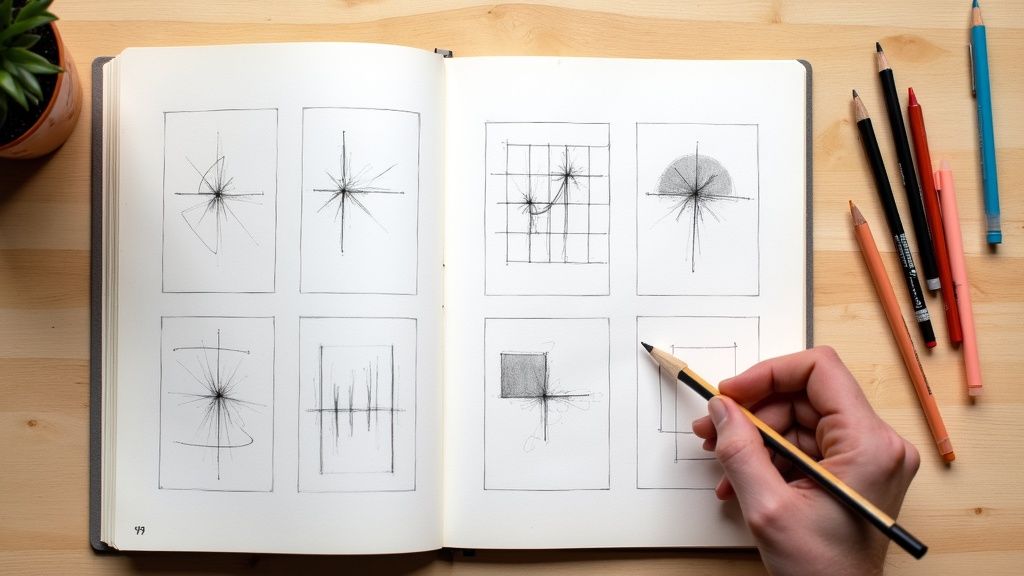Have you ever scrolled through social media, seen a charming doodle, and thought, 'I wish I could draw that'? The great news is, you can! The world of cute art isn't reserved for seasoned professionals; it's an accessible, joyful space perfect for beginners. The key is knowing where to start. Many aspiring artists feel intimidated by complex techniques and realistic proportions, but the secret to building confidence lies in mastering simple, satisfying projects. This guide is designed to bypass that initial frustration and get you straight to the fun part of creating.
We've compiled a fantastic list of cute drawings easy enough for anyone to tackle, regardless of their current skill level. You won't find complicated anatomy or frustrating perspective here. Instead, each idea is broken down into simple components, focusing on basic shapes and expressive details that deliver maximum charm with minimal effort. From kawaii-style animals and simple food characters to basic chibi people and doodle monsters, you'll find plenty of inspiration.
Whether you have five minutes or an hour, these prompts will help you fill your sketchbook, develop your own unique style, and prove that you have what it takes to create delightful illustrations. Prepare to grab your favorite pen or pencil and transform a blank page into something truly adorable.
1. Kawaii-style Animals: Mastering Cuteness with Simple Shapes
Kawaii-style animals are the perfect entry point for anyone searching for cute drawings easy enough for a beginner. Originating from Japanese popular culture, the term "kawaii" translates to "cute," and the art style is a masterclass in charm. It simplifies animals into their most adorable forms, using basic geometric shapes like circles and ovals as the foundation. This method removes the pressure of creating realistic anatomy and instead focuses on achieving an emotional connection through pure, distilled cuteness.
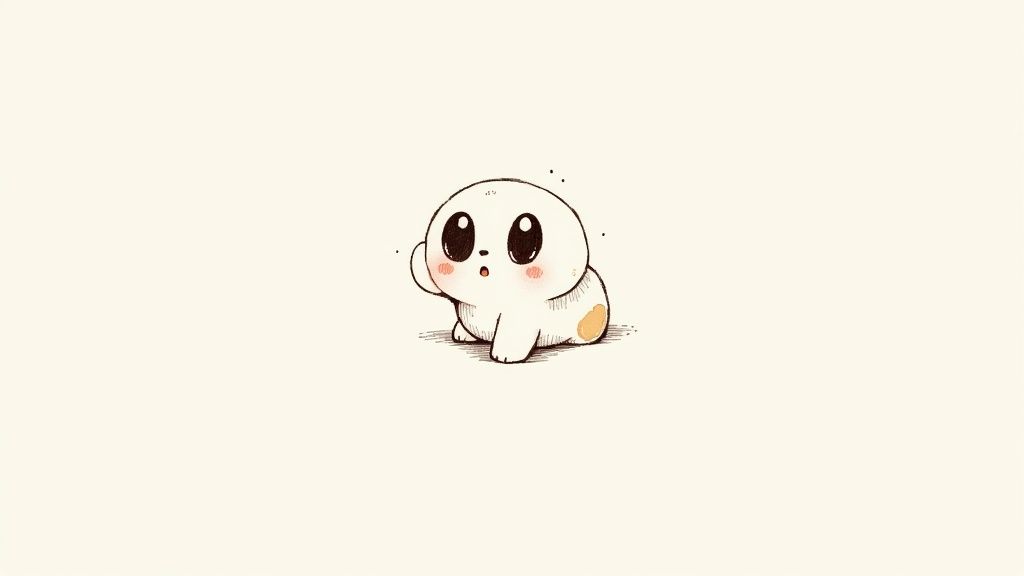
The style’s core principle is ‘less is more,’ which is why it’s so accessible. Think of iconic characters like Hello Kitty, Pusheen the Cat, or even simple Pokémon like Jigglypuff. They all share common traits: oversized heads, widely spaced eyes, and minimal detailing. Learning to draw in the Kawaii style is like learning a universal language of sweetness that can be applied to any creature you can imagine.
How to Draw Kawaii Animals
Getting started with these cute drawings is simple. The goal is to exaggerate features associated with youth and innocence.
- Foundation: Start with a large circle for the head. This will be the main focus of your drawing. The body is often much smaller, sometimes just a smaller oval attached to the head.
- Facial Features: Place the eyes low on the face, taking up roughly one-third of the total facial area. This creates a baby-like proportion that is inherently appealing. Keep them simple; two solid black circles are often all you need.
- Nose and Mouth: The nose should be very small, like a dot or an inverted triangle, to keep the focus on the big, expressive eyes. The mouth is often just a simple, small curve or completely absent.
- Limbs and Details: Keep the arms and legs short and stubby, like small ovals attached to the main body. For a classic Kawaii touch, add two small, pink ovals on the cheeks to represent blush marks.
This approach is ideal for artists of all levels because it prioritizes feeling over technical precision, making it one of the most forgiving and rewarding styles to learn.
2. Simple Food Characters: Giving Personalities to Your Favorite Snacks
Simple food characters are a delightful way to practice cute drawings easy enough for anyone. This approach involves taking everyday foods, from a slice of toast to a cup of boba tea, and giving them charming personalities. By adding simple faces and limbs to familiar shapes, you transform inanimate objects into endearing characters. This method is incredibly effective because it taps into the comfort and joy we already associate with food, making the resulting creations instantly relatable and lovable.

The concept has been popularized by Japanese character designers, food art on social media, and the endless variety of cute merchandise featuring smiling snacks. Think of the art found in bento boxes or the happy illustrations on children's menus. These drawings don't require complex skills; they rely on imagination and the ability to see a character in a simple shape. By learning to anthropomorphize food, you unlock a limitless world of cute, easy drawing ideas that are both fun to create and share. If you're looking for more inspiration in this niche, you can explore a whole world of kawaii food friends on drawinglist.com.
How to Draw Simple Food Characters
Bringing your food drawings to life is a straightforward process focused on adding expressive features to a basic outline.
- Foundation: Begin with the basic shape of the food you want to draw. A triangle for a pizza slice, a rectangle for a juice box, or a circle for a cookie. Keep the outline clean and simple.
- Facial Features: Place two simple dots for eyes in the upper third of the food's shape. This placement often creates a more youthful and appealing look. Use simple curved lines to create happy, smiling, or winking expressions.
- Limbs and Details: Add small, noodle-like arms and legs coming from the sides or bottom of the food. These don't need to be anatomically correct; their purpose is to add personality.
- Food-Specific Details: Enhance your character by including key details that identify the food. For a strawberry, add seeds. For a cupcake, draw sprinkles and a cherry on top. These small touches make your character instantly recognizable and add to its charm.
This drawing style is perfect for beginners because it builds on simple, recognizable shapes, allowing you to focus entirely on creating a cute and expressive character without worrying about difficult techniques.
3. Basic Chibi Characters: Adorable Human Figures Simplified
Venturing into drawing people can feel intimidating, but the Chibi style offers a fantastic and forgiving way to create cute drawings easy enough for anyone to try. "Chibi" is a Japanese slang word meaning "short person" or "small child," and in art, it describes characters with super-deformed proportions. This style intentionally swaps realism for charm by featuring characters with large heads, small bodies, and exaggerated expressions, making them instantly endearing.
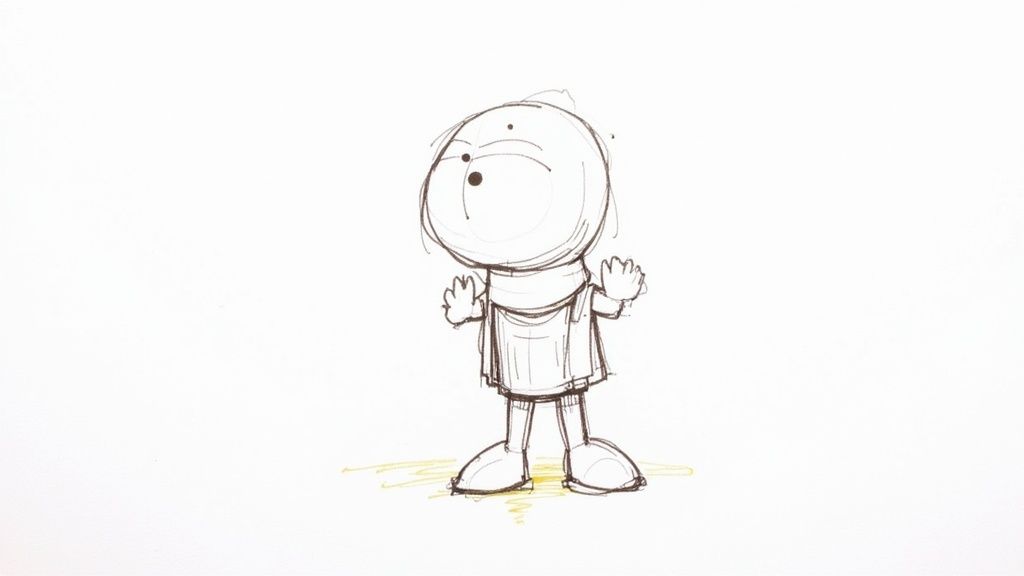
The appeal of Chibi art lies in its focus on emotion and personality over anatomical correctness. You’ll often see these lovable figures in anime merchandise, video games, and as social media avatars because they effectively capture a character’s essence in a compact, cute package. By simplifying complex human anatomy into basic shapes, the Chibi style empowers beginners to draw expressive and fun characters without getting bogged down in difficult details.
How to Draw Basic Chibi Characters
Creating a Chibi character is all about mastering their signature proportions. The key is to think in terms of heads, where the body is only slightly taller than the head itself.
- Foundation: Begin with a large circle for the head, as this is the focal point. The total height of your character should only be about two to three times the height of this circle. This establishes the quintessential "big head, small body" look.
- Facial Features: Divide the face into thirds to guide your placement. The eyes are usually large and expressive, occupying the middle third, while the nose and mouth are kept small and simple in the bottom third. This emphasizes the character’s emotional state.
- Body and Limbs: Keep the body small and simple, often just a bean or pear shape. The arms and legs should be short and stubby, lacking detailed joints like elbows or knees. Simple shapes for hands and feet (like mittens or small ovals) work perfectly.
- Exaggerate Emotion: A Chibi’s charm comes from its expression. Don’t be afraid to go over the top. If they are happy, draw a huge, wide-open smile. If they are angry, use sharp lines and dramatic sweat drops.
This method allows artists to focus on storytelling and personality, making it an excellent choice for creating original characters or fun fan art with a guaranteed dose of cuteness.
4. Cartoon Flowers with Faces
Transforming simple botanicals into charming characters is a wonderfully creative way to practice cute drawings easy enough for anyone. Cartoon flowers with faces add a layer of personality and emotion to a subject that is already beloved. By giving a simple sunflower a cheerful smile or a daisy a sleepy expression, you create an engaging character that tells a story. This approach is incredibly effective because it builds on familiar shapes, making it accessible even for those who are just starting their artistic journey.
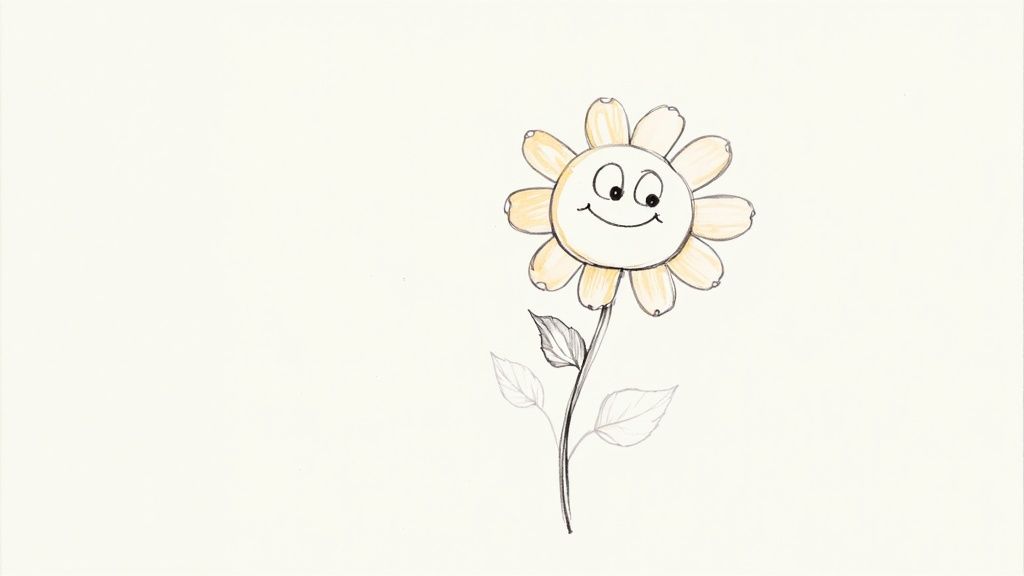
This style is prominent in children's book illustrations, greeting cards, and educational materials because it makes nature feel friendly and approachable. The concept is straightforward: take a basic flower outline and place a simple, kawaii-inspired face in its center. The magic lies in how this small addition can instantly bring the drawing to life, turning a static plant into a delightful being with its own mood and personality.
How to Draw Cartoon Flowers with Faces
Creating these botanical characters is a fun exercise in combining natural forms with expressive features. The key is to keep the shapes simple and the expressions clear.
- Foundation: Begin with a circle for the flower’s center. This is where you will draw the face, making it the focal point. Around this central circle, draw your petals.
- Petal Variety: Experiment with different petal shapes to give each flower a unique look. You can use classic rounded petals, pointed ones for a zinnia-like appearance, or even heart-shaped petals for an extra touch of sweetness.
- Facial Features: Inside the central circle, add two simple dots for eyes and a small curve for a mouth. You can convey a wide range of emotions with minimal changes: a U-shape for a happy smile, an O-shape for surprise, or closed eyes with an upward curve for pure joy.
- Finishing Touches: Draw a simple stem and a few basic leaves to ground your character. For added personality, consider giving your flower a tiny accessory, like a small bow tie, a hat, or even little blush marks on its "cheeks."
This technique is perfect for artists who want to create a whole world of unique characters with minimal effort. If you're looking for more inspiration, you can find a variety of other styles in these flower drawing ideas.
5. Stick Figure Scenes: Storytelling with Simplicity
Stick figure scenes are a fantastic way to create compelling and cute drawings easy enough for anyone, regardless of artistic skill. This approach takes the humble stick figure beyond a simple doodle and places it at the center of a narrative. Instead of focusing on anatomical perfection, stick figure scenes prioritize storytelling, emotion, and interaction. This method proves that you don't need complex characters to create artwork that is engaging, humorous, or even deeply moving.
The power of this style lies in its accessibility and universal readability. Everyone understands a stick figure, which allows the artist to focus entirely on the story they want to tell. Webcomics like Randall Munroe’s XKCD have mastered this art form, using minimalist figures to explore complex topics ranging from science and romance to existential dread. These simple drawings resonate because they distill an idea or feeling down to its purest form, making the message clear and impactful.
How to Draw Stick Figure Scenes
Creating an effective stick figure scene is about communicating a story or emotion clearly. The goal is to make simple lines feel alive and intentional.
- Focus on Body Language: The pose is everything. Bend the knees to show sitting, raise the arms for excitement, or tilt the head to convey curiosity. Exaggerated gestures make the characters’ emotions and actions immediately understandable.
- Use Simple Props: A single prop can establish an entire context. A flower can signify romance, a book can represent learning, and a simple box can become a mysterious object of interest. Props give your characters something to interact with.
- Keep Backgrounds Minimal: The background should support the scene without overpowering it. A single horizontal line can be the ground, a wavy line can be water, and a simple rectangle can be a doorway. Only include what is necessary to set the scene.
- Add Text for Clarity: Don't be afraid to use speech bubbles, captions, or simple labels. Sometimes a few words can provide the perfect punchline or emotional context that a drawing alone cannot, transforming a simple sketch into a complete comic strip.
This technique is perfect for anyone who feels intimidated by drawing but has stories to tell. It’s a powerful reminder that the heart of art is communication, not technical perfection, making it one of the most rewarding types of cute drawings easy to master.
6. Doodle Monsters: Unleashing Creativity with Friendly Creatures
Doodle monsters offer an incredibly fun and liberating way to create cute drawings easy for any skill level. The beauty of these whimsical beings is that there are no rules. They thrive on imperfection and celebrate creative freedom, making them an ideal subject for artists who want to experiment without the pressure of realism or strict proportions. Unlike scary monsters, these creatures are designed to be friendly, goofy, and charming, turning potential frights into delightful friends.
This drawing style is all about letting your imagination run wild. Think of the lovable characters from Pixar's Monsters, Inc. or the quirky illustrations in children's books. These designs aren't bound by anatomy; they are built from spontaneous shapes and personality-filled details. Drawing doodle monsters is less about technical skill and more about expressing a mood, making it a fantastic exercise for boosting creativity and overcoming the fear of the blank page. If you're looking for more inspiration, exploring a wide range of doodle drawing ideas on drawinglist.com can provide a great starting point.
How to Draw Doodle Monsters
The process for creating these cute drawings is wonderfully straightforward and encourages you to embrace happy accidents. The goal is to build a unique character from simple, playful elements.
- Foundation: Start with an abstract shape. A lopsided circle, a stretched-out blob, a fuzzy scribble, or an uneven rectangle can all serve as the body. Don't aim for perfection; the quirkier the initial shape, the more character your monster will have.
- Facial Features: This is where the personality shines through. Give your monster multiple eyes of different sizes, a single cyclops eye, or even eyes on stalks. Expressions should be friendly, so try a wide, goofy grin, a small, curious smile, or a surprised "o" shape for a mouth.
- Unique Details: Add features that make your monster unique. Think small horns, tiny wings, mismatched antennae, or a tuft of fur on its head. Decorate its body with simple patterns like spots, stripes, or zig-zags.
- Limbs and Extras: Draw stubby legs, long, wavy arms, or even no limbs at all. Symmetry is not required and often makes the design less interesting. The key is to keep adding elements until you feel your friendly creature is complete.
This method is perfect for warm-up sketches or when you simply want to have fun with your art, proving that some of the cutest drawings come from the most unstructured and joyful approach.
7. Simple Cat Faces: Capturing Feline Charm with Minimal Lines
Simple cat faces are a fantastic choice for those looking for cute drawings easy enough for anyone, regardless of artistic skill. This approach isolates the most recognizable and beloved feline features-triangular ears, expressive eyes, and delicate whiskers-to create an instantly charming and identifiable cat portrait. It strips away the complexity of anatomy and fur texture, focusing entirely on the minimal elements that define a cat’s face, making it a powerful exercise in creating impact with simplicity.
The widespread popularity of this style can be seen everywhere, from cat cafe logos and internet memes to minimalist merchandise and simplified pet portraits. The goal is not realism but recognition and emotion. By focusing on a few key lines, you can convey a wide range of feline expressions, from curious and playful to sleepy and content. This makes it an incredibly versatile and rewarding drawing subject for beginners.
How to Draw Simple Cat Faces
Getting started with these cute drawings is a straightforward process centered on basic shapes and clean lines. The key is to capture the essence of "cat" without getting lost in the details.
- Foundation: Begin with a circle or a slightly squashed oval for the head. This shape will serve as the canvas for all the facial features.
- Ears: Add two triangular ears on top of the head. You can place them close together or far apart to change the cat's character.
- Eyes: Position the eyes roughly one-third of the way down from the top of the head. Experiment with different shapes: simple dots for a classic look, upward curves for a happy cat, or horizontal lines for a sleepy one.
- Nose and Mouth: Place a small, inverted triangle in the center of the face for the nose. From the bottom point of the nose, draw a small "w" shape or two simple curves for the mouth.
- Whiskers: Finish by drawing three straight or slightly curved lines on each cheek, radiating outward from near the nose area.
This method is perfect for anyone wanting to create universally appealing art quickly. It’s an ideal way to practice conveying emotion and personality through minimal visual information, making it a foundational skill for any aspiring artist.
Cute Drawing Styles Comparison Guide
Style | Implementation Complexity | Resource Requirements | Expected Outcomes | Ideal Use Cases | Key Advantages |
|---|---|---|---|---|---|
Kawaii-style Animals | Low | Basic shapes and markers | Cute, simplified animal illustrations | Beginners, character stickers | Beginner-friendly, quick and versatile |
Simple Food Characters | Low | Basic shapes and coloring | Adorable food with faces | Food merchandise, children's art | Familiar subjects, widely relatable |
Basic Chibi Characters | Low to moderate | Basic anatomy understanding | Expressive, cute human-like characters | Anime fans, manga, social media | Focus on expression, quick to create |
Cartoon Flowers with Faces | Low | Simple shapes, colors | Cheerful, cute botanical characters | Greeting cards, kids' illustrations | Nature-themed, appeals to all ages |
Stick Figure Scenes | Very low | Minimal tools (pen/paper) | Emotional, narrative stick figure art | Comics, instructional content | Extremely accessible, storytelling |
Doodle Monsters | Low | Creativity-focused, basic tools | Whimsical, friendly monster designs | Kids' books, art therapy, branding | Encourages creativity, no rules |
Simple Cat Faces | Low | Basic shapes and lines | Recognizable, minimal cat portraits | Memes, branding, pet art | Expressive with minimal elements |
Your Creative Journey Starts Now
You have just navigated a vibrant landscape of creative possibilities, exploring seven distinct and wonderfully accessible categories of cute drawings easy enough for anyone to tackle. From the simplified, heartwarming forms of Kawaii-style animals to the expressive freedom of little doodle monsters, the journey from a blank page to a charming illustration is shorter and more enjoyable than you might think. This guide has equipped you with the foundational building blocks, proving that you don't need years of training to create something that makes you smile.
The most critical takeaway is this: action overcomes intimidation. The gap between wanting to draw and actually drawing is bridged by a single, simple decision to pick up a pen and start. Remember the core techniques we covered, like using basic shapes (circles, ovals, and triangles) to construct everything from a chibi character's head to a cartoon flower's petals.
Turning Inspiration into Action
Now is the perfect moment to put these ideas into practice. Don't let the inspiration fade. Your next steps are not about achieving a masterpiece but about building momentum and confidence through playful experimentation.
- Choose Your Fighter: Select one category from the list that sparked the most joy for you. Was it the simple cat faces or the personality-packed food characters? Start there.
- Embrace Imperfection: Your first attempt won't be your best, and that's the point. Every line you draw is valuable practice. Focus on having fun and letting the character's personality emerge, rather than chasing flawless symmetry.
- Mix and Match: The true magic begins when you start combining concepts. Why not draw a Kawaii-style doodle monster holding a tiny cartoon flower? Or create a stick figure scene where the characters are interacting with chibi animals? This is how you develop a unique style.
The Lasting Value of a Simple Doodle
Mastering these cute drawings easy techniques does more than just fill a sketchbook. It's a powerful tool for visual communication, personal expression, and even stress relief. Being able to quickly sketch a cute character can enhance your note-taking, personalize a birthday card, or simply provide a mindful escape from a busy day. It’s a skill that grows with you, a creative outlet that is always available.
The path forward is paved with consistent, joyful practice. Dedicate a few minutes each day to a simple sketch. You will be genuinely surprised at how quickly your skills develop and how soon you are inventing your own adorable creations from scratch. The journey of a thousand drawings begins with a single, cute one.
Ready to keep your creative momentum going with endless inspiration? The Drawing List generator provides thousands of unique and specific prompts, including entire categories dedicated to "Kawaii" and "Doodle" art, to ensure you never face a blank page again. Discover your next favorite character idea and continue your artistic journey at Drawing List.
